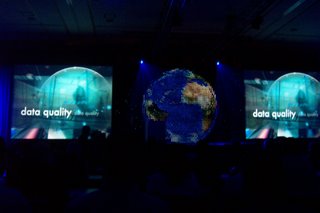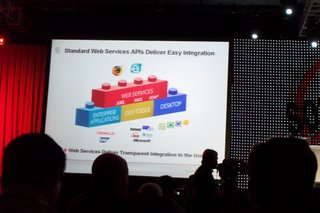As always, Informatica's created a great atmosphere for the keynotes.

 President and CEO Sohaib Abbasi
President and CEO Sohaib Abbasi gave his usual speach about the complexity of the data integration landscape and how Informatica, as the premier DI company, is about so much more than data warehousing. This year's theme, though, seems to be focused around integrating data from
BPO and
SaaS operations. Informatica announced a PowerCenter Connect for
salesforce.com that it plans to follow with SaaS connects for other providers as well. Sohaib also shared that Informatica's own software roadmap leads toward implementing PowerCenter as an on demand service as well, integrated into applications like salesforce.com. (To be honest, what surprised me is what a big operation salesforce.com has become. The support SFA for Cisco!) Sohaib also shared a great demo of how Similarity's Data Cleansing integrates into PowerCenter.

This transitioned perfectly, of course, into the next keynote speaker,
Marc Benioff, Chairman and CEO of salesforce.com. Marc focussed more on Web2.0 and how the "business web" is becoming more and more prevalent with applications like salesforce.com. Well defined business operations can be packaged up and outsourced as a software service over the web. He did live demos of salesforce.com as well as other applications like Adobe's pdf creator and
Writely and various Google maps mashups. Obviously on the cutting edge of the business web, Marc shared some powerfully exciting insights about the future of business operations and how applications might integrate in the future.

Finally, Accenture was back again with
Royce Bell and Shari Rogaliski to present some powerful insights about information management. (I always enjoy Royce's presentation style and British sense of humor.) After gracing us for five minutes with a slide of a statue of a naked man... Royce spent most of the speach alluding to Malcolm Gladwell's "
Blink", and how important it is to bring information to users in context rather than simply flood them with information. It gives them the ability build the intuition used in decision making from a continuous exposure to real facts.










 Although you can't tell, this is a demo of the new Java transformation available in PowerCenter 8. I think that was one of the better additions to PC. It provides easier access to an environment that allows you to easily implement more classic procedural logic: looping, recursion, etc. I've never really jumped on the Java bandwagon - I grew up as a real programmer with real programming languages like 68k assembler, Scheme, and C. Embedding Java in databases seemed like a silly idea to me, but I think I'm finally coming around to the whole idea of embedding Java in other tools. (I still call it the COBOL of the 90's, though.)
Although you can't tell, this is a demo of the new Java transformation available in PowerCenter 8. I think that was one of the better additions to PC. It provides easier access to an environment that allows you to easily implement more classic procedural logic: looping, recursion, etc. I've never really jumped on the Java bandwagon - I grew up as a real programmer with real programming languages like 68k assembler, Scheme, and C. Embedding Java in databases seemed like a silly idea to me, but I think I'm finally coming around to the whole idea of embedding Java in other tools. (I still call it the COBOL of the 90's, though.)







